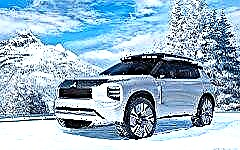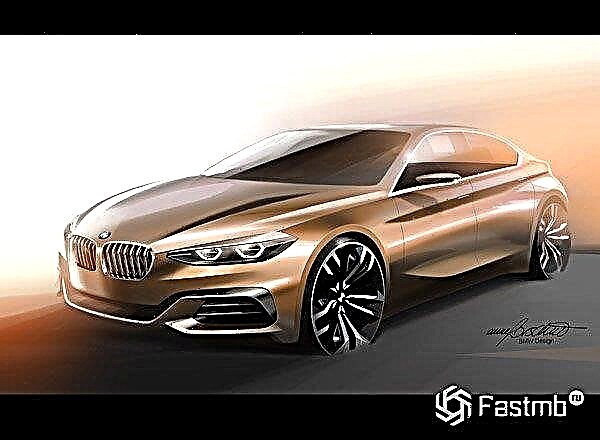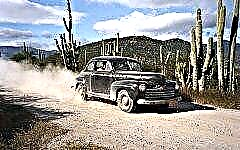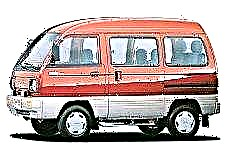

The content of the article:
- Automotive industry of Uzbekistan
- Cars of Kyrgyzstan
- Cars in Tajikistan
Chery and Geely, Kia and Hyundai, Honda and Lexus, as well as several other leading automakers, are headquartered in Asian countries, creating jobs and lower-cost options for their models.
Is there a car industry of its own in the countries of Central Asia, and what kind of cars do local motorists prefer to drive?
Automotive industry in Uzbekistan

In the photo: Daewoo Damas
Due to the nature of the landscape, drivers of this country prefer either small-sized or passable models. An important factor is the purchasing power of citizens who cannot afford premium brands.
Just a quarter of a century ago, the automotive industry did not exist in Uzbekistan, and the visit by the President of Uzbekistan to South Korean automobile factories is considered the starting point of its birth.
The visit resulted in an agreement on the construction of a joint venture called UzDaewooAuto, signed in 1993.
The volume of production of the new plant fully satisfied not only the domestic demand for cars in Uzbekistan, but even made it possible to send products for export to the closest neighbors - Pakistan, Afghanistan, Georgia.
The quality of the manufactured models is supported by the regular training of the company's personnel with experienced car manufacturers - Daewoo, General Motors and others.
One of the most interesting models can be called the Daewoo Damas micro van, which began to be produced in 1991 and is still being produced.
Externally, it echoes the Suzuki Carry, but inside it has a 38-horsepower 0.8-liter engine located under the front seats and paired with a manual 5-speed transmission.
Surprising is the fact that the engine of this van is not just low-powered, but still carbureted, which does not prevent it from quite briskly accelerating both an empty and a loaded car.
Having about 3 meters in length and 1.5 meters in width, the car accommodates three rows of seats for 8 passengers and about 560 kg of cargo, which allows it to be effectively used for personal needs and for commercial cargo transportation. Only air conditioning is offered as additional equipment, but fuel consumption in the city is only 4.1 liters per 100 km.
Comfort and safety are out of the question - lack of ventilation and airbags, extremely hard seats, and the head restraints are even tripled at the level of the shoulder blades.
There is also a separate modification, exclusively for cargo, with only two front seats.
The microvan also has other names - Daewoo Attivo in some Asian car markets and Chevrolet CMV - for export versions already produced under the leadership of General Motors.
In 2006, the model underwent "reystaling", becoming more powerful and comfortable. Changes were also made to the dimensions, since the designers added 26.5 cm to the front of the car in order to improve the safety of the passengers in front. The headlights, bumpers and rear-view mirrors have undergone aesthetic modernization, and the sidewalls have acquired branded stickers.
In 2014, production moved to the new Khorezm Auto plant in Pitnak, and in 2016 the Daewoo brand was replaced by Ravon. Daewoo Damas itself is ubiquitous in Uzbekistan as ambulances, minibuses, trucks and family cars.

In the photo: Daihatsu Cuore
Another car, better known in Asian countries, is called Daihatsu Cuore. This key car, produced in 1998-2000 and having a liter engine, carried the idea of combining front-wheel drive, an economical engine and a large and comfortable interior space for 4 people.
It is not surprising that the car, which received a 5- and 3-door version, is urban and maneuverable, spending no more than 5 liters per hundred kilometers, quickly won the trust of motorists.
In the "heart" of Daihatsu Cuore, a 3-cylinder 45, 56 or 58-horsepower power unit was installed, and in a separate modification, a 64-horsepower turbocharged one, reaching speeds of up to 140 km / h.
Cars of Kyrgyzstan

In the photo: Honda Odyssey
In this country, there is no own production of cars, as well as the production of auto parts or other consumables. However, here in different periods of time, transport has been steadily falling in price, and therefore there was a consistently high demand for its purchase from secondary car markets around the world.
As the statistics of the last decade show, almost all cars were imported from Japan, after which they were resold in neighboring republics. Therefore, right-handed cars from Japanese secondary markets can really be called “popular” models in Kyrgyzstan.
Honda Odyssey, produced in 2000-2005, was a family minivan that became the absolute leader in sales in the republic. Its popularity peaked in 2005 and lasted until 2013, when it was no longer imported into the country.
The car offered 7 seats, a 2 or 3 liter engine, an automatic transmission and an Accord base. The low floor and center of gravity provided comfortable boarding for passengers, and at the same time loading luggage. The 6-seater EX trim also offered a roof rack, adjustable driver's seat, an electric sunroof, and a decent audio system.
To minimize production costs, the model was equipped with a 4-cylinder 2.2-liter 145-horsepower engine. When sales soared upward, it became clear that the line of power units needed to be expanded. Therefore, subsequent modifications had a 150-horsepower and even a 3-liter 200-horsepower front-wheel drive engine. The only transmission was installed on all engines - a 4-speed automatic.
As part of the exchange of experience, Honda presented its developments to a colleague - Isuzu. For this automaker, the model, which they renamed the Isuzu Oasis, was the first and last minivan in the brand's long history.

In the photo: Honda Stepwgn
The Honda Stepwgn, which was produced from 2001 to 2006, also enjoyed comparable popularity. In terms of interior, exterior and even technical characteristics, this car was surprisingly similar to the Honda Odyssey, and therefore became a truly "cult" car.
Since the residents of Kyrgyzstan primarily value the functionality of their transport, an abundance of seats, an automatic transmission with a minimum set of service functions and an affordable price - a set of these qualities makes the model an invariable sales leader in the republic.

In the photo: TARZ-002B
Among the unique cars of our own production, one can single out the all-metal buses TARZ-002, produced since 1976 and affectionately nicknamed "loaf".
This creation of the Tokmak Automobile Plant had enough design flaws and technical defects, which led to the regular release of new modifications.
An interesting difference between the Kyrgyz "loaves" from similar Kurgan buses was the original route indicator.
Cars in Tajikistan

In the photo: Opel Astra G
Of its own production in the republic, there is only the Chkalovsky bus plant, which has existed since 1953 and produces wagon-type buses.
In 2018, information appeared that a new car plant would be opened in Dushanbe with the support of Turkish sponsors. At first, he will assemble freight vehicles and buses, but later he will develop unique products under the Made in Tajikistan brand.
Nowadays, among the motorists of Tajikistan, interest in large-sized European cars prevails. One of the most popular and inexpensive models is the Opel Astra G, which they prefer to purchase from Russian car factories.Drivers liked the 1.6-liter petrol engine, roomy 5-seater cabin, spacious trunk and several trim levels with different powertrains and a choice of transmissions.

In the photo: Hyundai Elantra
Auto ladies prefer the Hundai Elantra, which is also a very affordable car with a similar 1.6-liter engine. Models with a mechanical transmission and produced in the period 2002-2007 are mainly imported into the republic.

In the photo: Lada Priora
The rating is summed up by the Russian auto industry in the form of Lada Priora, which are purchased not only in the secondary market, but also new ones directly from showrooms. Models of the 2000-2009 model with 1.6-liter engines and "mechanics" are in particular demand.
Conclusion
It cannot be said unequivocally that a program for the development of the automotive industry was worked out in the Soviet Union, although each republic had its own, sometimes unique, sometimes duplicating another plant, the production of vehicles.
After the collapse of the country, enterprises began to fade away, and now the states of Central Asia mainly serve only as branches of assembly plants for the world's auto giants.











